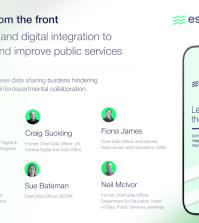Pick up the pace: CIO Catherine Luelo on accelerating Canada’s digital journey

Nine months after joining the public service, CIO Catherine Luelo tells Matt Ross how she’s refreshing Canada’s digital strategy – and asks staff across the workforce for their help in improving government’s use of data
“What I’m trying to do,” says Catherine Luelo, “is point everyone in a common direction; to say: ‘There’s our North Star. That’s where we’re going. These are the priorities we’re working on, and let’s start to orient everybody. We may not all be on the same path, the same road, but we’re all going to be heading to the North Star’.”
Nine months after beginning work as Canada’s chief information officer, Luelo is on the verge of publishing a “refreshed” digital blueprint – replacing the Digital Government Strategy and Digital Operations Strategic Plan with a single document that sets out how to “do government in a digital age”.
This plan, she explains, aims to speed delivery of transformation projects, improve government’s use of data, strengthen policy implementation and boost talent development. And to hasten progress in all these fields, Luelo is also serving as a ‘champion’ of the Public Service Data Challenge: a new staff development programme designed to uncover good ideas for how government could better use data, and to push them down the road towards implementation.
Pick up the pace
So there’s a lot going on in the Office of the CIO (OCIO), which sits in the Treasury Board of Canada Secretariat. Since exiting her 30-year business career – which included stints as the CIO of Air Canada and energy firm Enbridge – for a new life in public service, Luelo has been finding her way around the system: “I have a curiosity about getting to know people and building new relationships, and that’s served me particularly well as I’ve come into government,” she comments.
Now she’s keen to get moving, accelerating progress on the digital agenda. “I have learned patience a little bit” while working for big corporates, she says, “but there is a speed of government: there is a pace that things go. And part of I think why I was attractive to PCO [Privy Council Office] to play this role was they wanted someone who would come in and say: ‘I don’t subscribe to that pace’.” In “this very complex environment,” she adds, she is working out where to push hard and where to “let the pace be the pace”.
In part, she explains, refreshing the digital strategy is about changing the language: rather than talking about ICT, she wants Canadians to understand how reforms will improve “how I interact with government, and the services that I’m able to access”. The new document rests on four main pillars, she explains, with the first providing “a focus on ensuring that we get the large programmes delivered – because we have some old systems – and having a replicable model around transformation for different departments across government to undertake that”.
System change
This work got a fillip on 7 April, when the 2022 Budget promised legislative changes enabling the Canadian Digital Service (CDS) “to provide its digital platform services more broadly, including to other jurisdictions in Canada”: platforms such as Notify and Forms provide common building blocks, easing the task of building new services. “We were high-fiving with the CDS folks” when the news came through, recalls Luelo. “CDS needs to be able to be that innovator within government – a start-up, but a start-up that scales – and they also need to be in a position to help the rest of the town advance their digital practices.”
Read more: Letter from Ottawa: After a winter of shocks, Canada’s Budget is the latest sign of stability
Hastening service transformation, though, is as much about changing business processes as deploying technologies. A classic case is that of the Phoenix pay system, which the government – having endured six years of errors and staff complaints – is currently working to replace. In March, unions and the government agreed to discuss simplifying the complex pay rules which lie behind many of Phoenix’s failures: federal bodies currently maintain 37 HR systems, 105 collective pay agreements and some 80,000 different pay rules.
“We learned some hard lessons on Phoenix,” comments Luelo. “A good organisation integrates that into the things they do next, to make sure they don’t happen again. And part of my office’s role is to ensure that we’re the mechanism within government to have that level of oversight.”
“It would not be the right decision to take everything we’ve got in Phoenix and move it over to a new platform,” she comments, welcoming the pay talks. “If we’re not transforming the process and the underlying ways of working and the business rules, could and should we expect a different outcome on a new pay system?” A set of pilots are underway to “see what outcomes we can get” by simplifying some of these rules, she adds. “That’s the needle we’re trying to thread right now.”
Information is power
The second pillar of the refreshed strategy focuses on data; and here “we’re planting a flag on digital identity,” Luelo says. “We are getting very aggressive with the fact that we need to advance the digital identity file for Canada.” Working with the provinces and territories, “the next six months is going to be about establishing a workable plan for three layers of digital identity”.
The first of these involves national bodies moving “to a common enterprise platform for Government of Canada services,” enabling citizens to access ever more federal services in a single place while whittling down the 46 existing front doors. The second layer will see the development of a “pan-Canadian trust framework”, establishing some common rules for data management through the various layers of government. And the third – an “integration transit layer” – will ensure that citizens’ digital identities are recognised across the public sector, “so that the provincial ID is usable for all services, and all services link into this common platform, and there’s a handshake”.
Read more: Former CIO warns that Canada lacks the ‘building blocks’ of digital economy
Luelo has established a programme office and an ad hoc group of senior officials to pursue digital ID, she says, and president of the Treasury Board Mona Fortier – an MP and minister – is “putting her shoulder behind it as one of her top priorities”. Progress over recent years has been patchy, she acknowledges, but now “I feel we’re well positioned and well supported”.
Policy and people
The strategy’s third pillar, Luelo continues, focuses on “action-ready policy”: strengthening the connections between policymaking and implementation. And its fourth concerns workforce development: “We’ve got a talent deficit in our country – not just for government technology roles, but for all technology roles – and a very low unemployment rate,” she explains. “How do we get new talent in?”
In part, Luelo believes, the answers lie in stronger public service workforce management: “There is a much bigger role that we’re going to play as the owner of the community of technology folks within government,” she says. Her office can, for example, create “pools of talented… qualified, equipped candidates” on which departments can draw, hastening recruitment. She wants to look in “alternative places for talent”, commenting that flexible, remote-working public service digital jobs often suit persons with disabilities. “Neurodiverse candidates can lend themselves beautifully to this kind of work,” she adds. And she suggests that “an aggressive interchange programme with industry could lead to some really interesting ways for us to fill some of our talent gaps and start to speak each other’s language”.
Playing round the cutting edges
Luelo’s refreshed strategy is designed to raise the pace on digital transformation – and, importantly, she’s focusing on the tools used by public servants in their daily jobs as well as the public services available to citizens. This agenda isn’t just “about the outward-facing things; it needs to be about the information that you serve up to those [staff who] need it to make decisions,” she comments.

The public service’s ageing, inflexible internal systems make it difficult, for example, to access the insights locked into its data assets. “We’ve got older systems that need to be modernised and replatformed,” notes Luelo. “That can become a bit of a barrier to some of the innovation that we want to do around data.”
Nonetheless, she argues, it’s possible to “do innovative work, because there are ways to work in older systems” without making big, structural changes: “integration layers” can be added to combine and analyse separate datasets, for example. And augmenting and connecting systems can be almost as powerful as replacing them: “Don’t ever underestimate the [value of] playing around the edges, because sometimes that can become the thing that can really unlock some value in the organisation,” she comments. “That’s the really exciting part about what we’re doing in the Data Challenge.”
Luelo is on the look out for ways to demonstrate that by “doing data differently, there is value to Canadians” – and she hopes that the Public Service Data Challenge (PSDC) will unearth some promising projects. Launched two weeks ago by Statistics Canada, Natural Resources Canada and Global Government Forum, the programme aims to tap into the ideas, expertise and enthusiasm of public servants right across – and at every level within – the workforce.
A Challenge for public servants
“Nobody knows our data systems better than the public servants who use them every day,” says Luelo. “Tell us how to fix problems or recognise opportunities – the Data Challenge creates a space where we can build teams around the best ideas, and provide resources to move them forward.” Filling in a simple form, public servants can send in their data-related ideas for how to improve government’s tools, systems and services. A judging panel of senior public service data specialists will pick the eight most promising, and the organisers will assemble interdisciplinary, cross-departmental teams to take them forward – whittling down the list at ‘Dragon’s Den’-style semi-final and final events, until one or more winners are selected.
As well as submitting ideas, Luelo notes, public servants can volunteer to join these interdisciplinary teams – learning new skills in a highly creative environment. “When you bring together all these different people on a common problem, you apply different lenses of thinking – and that’s where the magic can happen,” she says, noting that working with people from other professions “makes me better at my day job, because I think about things in a broader context”. The PSDC allows public servants “to work with people that you normally wouldn’t work with, on a problem that you’re motivated to solve,” she adds. “I think it’s a pretty neat opportunity.”
The programme’s ‘champions’ and its sponsoring organisations are, Luelo notes, keen to take the best ideas forwards to implementation. Canada’s chief statistician Anil Arora “and I are tied hip-to-hip on this, along with our colleagues in PCO,” she says, noting that organisers have “got all the right sponsors around the Data Challenge table, with both the desire and the authority to get things rolling. And right now, we’re looking for good ideas to help us be more efficient, and to demonstrate the fact that we can use data in a different way to solve problems”.
Prioritise, then push
So these are Luelo’s priorities in the job: talent management, policy implementation, data and digital identity, and moving forward key modernisation and transformation projects. She recognises that realising those aims will involve deprioritising other goals: as public servants emerge slowly from two intense years tackling the pandemic, “this can’t just be about adding work: it needs to be about taking some work away,” she comments. “Part of the thing that we need to bring to the table as senior leaders is the ability to say: ‘It’s okay to not do an A-paper on that; that’s a C-paper,’ or: ‘That’s super important, but not right now’.”
Read more: Asking the right questions: an interview with Canada’s stats chief, Anil Arora
And in the areas where she’s prioritising progress, Luelo is clearly ready to press forward quite firmly. “We have to claim the enterprise space,” she says, and “go on to say: ‘This is the stuff that we are going to standardise.’ And then I don’t think it’s optional.” When public service leaders argue that their organisation’s work is so unique they should be exempted from common policies and platforms, she adds, “I just roll my eyes and go: ‘Oh my gosh, it’s like every discussion I’ve ever had with a business leader’ – ‘I’m special, I’m different, I can’t do it the way you want me to do it’.”
To date, she adds, the OCIO hasn’t made full use of its existing powers: “There’s some things we’ve already claimed [where] we have not been good on getting people into the stream. We’ll start there,” she says. The government’s Enterprise Architecture Review Board has created some great tools, she argues, “but we have to have the courage to enforce. And that’s a very strong word, but you can ask people for so long to do the things you need them to do. And when them not doing it drives complexity and risk and cost into doing something, and [where that] doesn’t create a competitive advantage, that’s when you get into the enforce”.
Nine months into the role, Luelo is pointing to her North Star – and signalling her determination to reach it. Meanwhile, she says, she’s loving the sense of public service in her new job: “There is a very mission-driven group of people working with the Government of Canada,” she says. “They’re making a difference in what’s going on in Canadians’ lives right now, and I’m just thrilled to be a part of that.”
And after 30 years in a range of different industries, Luelo is enthused by the sheer breadth and scale of government’s responsibilities and operations. “The problems that we get to work on are big, interesting, complex. We do economic and social development, climate, defence, immigration; the scope is fascinating. It makes my brain happy and sore at the same time,” she concludes. “I feel a little bit like I’ve been training for this assignment for all of my life.”
To submit an idea to the Public Service Data Challenge, or to volunteer to join an interdisciplinary team, please visit the website https://canada.governmentdatachallenge.com/























